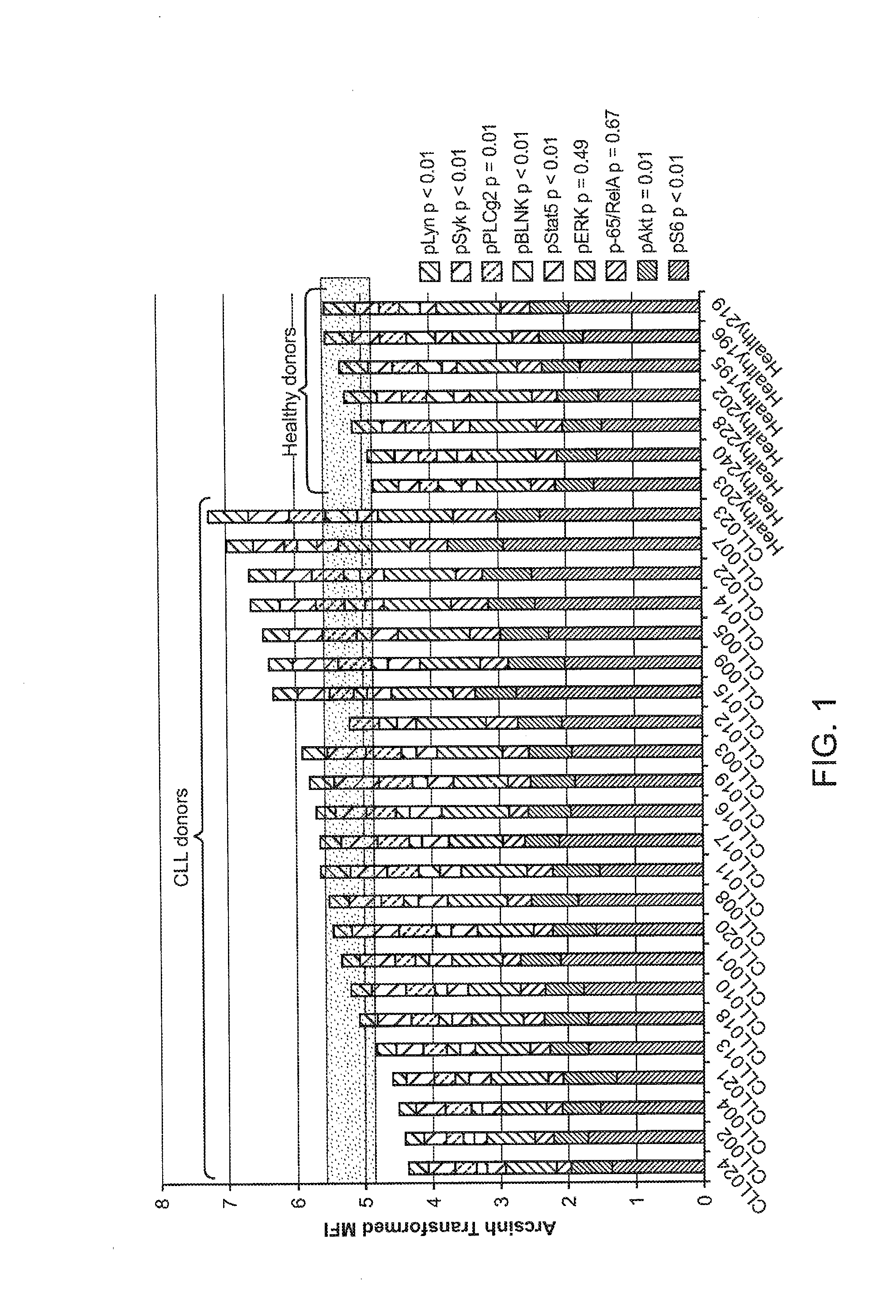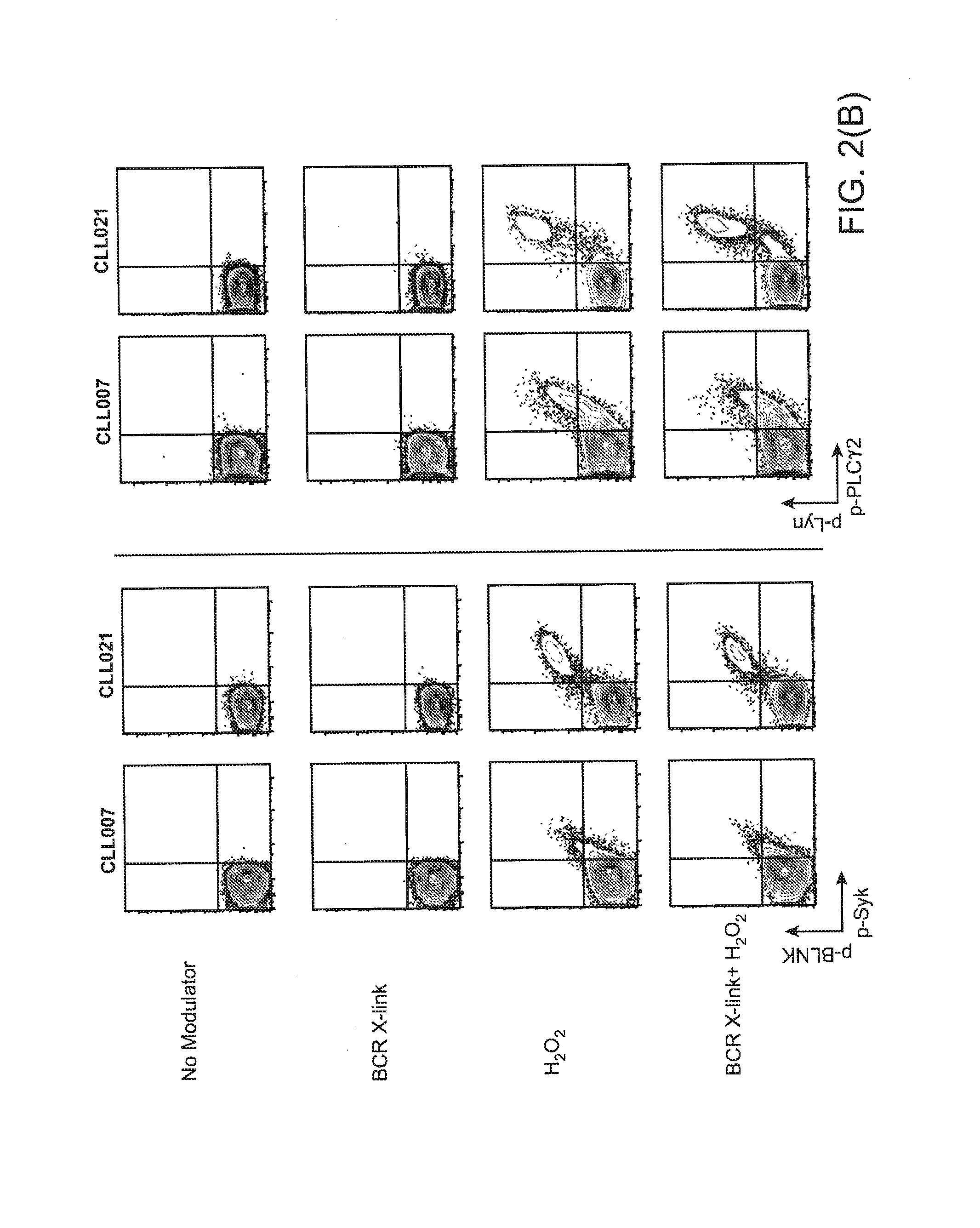Methods for diagnosis, prognosis and methods of treatment
a prognostic and treatment method technology, applied in the field of diagnosis, prognosis and treatment methods, can solve the problems of refractoriness or resistance to therapy, discordance between the predictive value of disease outcome and the outcome of disease, and many protein components
- Summary
- Abstract
- Description
- Claims
- Application Information
AI Technical Summary
Benefits of technology
Problems solved by technology
Method used
Image
Examples
example 1
Signaling Pathways in CLL Samples
Cell Preparation
[0363]Intracellular network responses of CLL patient samples subjected to modulators of signaling, were analyzed using flow cytometry-based Single Cell Network Profiling (SCNP). Of the many signaling modulators studied, H2O2 treatment (a general inhibitor of tyrosine phosphatase activity) stratified CU, patients into two subsets, one showing augmented BCR signaling and the second with little or no response. These data suggest that differential phosphatase activity with consequent aberrations in tonic (ligand independent) signaling proximal to BCR signaling was driving the biology of these two patient groups. Importantly, signaling in patients was reflected in all the measured components of the canonical B cell receptor network. Thus, p-Lyn, p-Syk, p-BLNK, p-PLCγ2, p-Erk and p-Akt showed parallel phosphorylation responses and were either augmented in unison, or not activated at all. In vitro F-Ara-A-exposure of samples from the same gr...
example 2
[0424]Single Cell Network Profiling (SCNP) Defines Prognosis beyond IGHV Mutational Status in CLL.
[0425]In order to assess the correlation of B-CLL biology (measured by SCNP) and clinical course in a clinically homogeneous population, samples collected as part of a Phase II clinical trial from elderly patients with previously untreated B-CLL prior to therapy initiation were assessed. See FIG. 7 and FIG. 27 for the biology that was analyzed.
[0426]B-cell chronic lymphocytic leukemia (B-CLL or CLL) is a disorder that with a highly variable clinical course. Some patients experience indolent disease and don't require treatment for several years, often surviving for over a decade, while others have a more aggressive form that requires early treatment. Current prognostic factors available to stratify patients include IGHV mutational status, ZAP70 expression, cytogenetic risk profile, and CD38 expression. While these can help assess disease risk, no reliable method currently exists to predi...
example 3
[0460]In this Example, patients with CLL at various timepoints before treatment and healthy controls were analyzed to 1) map SCNP signaling profiles in early-stage B-CLL and to 2) identify signaling associations with clinical subgroups defining B-CLL prognosis (IgVH mutational status, cytogenetic risk, CD38 / ZAP70 expression).
Patients and Samples
[0461]Peripheral blood mononuclear cells (PBMCs) were obtained from 39 B-CLL patients between 2006 and 2007, Rai stage 0-II, at different time points during their clinical course but prior to the initiation of treatment. PBMCs from four age-matched healthy donors were collected at the Stanford Blood Center. All donors provided informed consent for research purposes. SCNP assays were performed blinded to clinical data. Diagnosis and initiation of treatment for B-CLL were based on 1996 National Cancer Institute-Working Group (NCI-WG) / IWCLL 2008 Guidelines for Diagnosis and Treatment of CLL. Clinical and biological disease characteristics at dia...
PUM
| Property | Measurement | Unit |
|---|---|---|
| frequency threshold | aaaaa | aaaaa |
| median time | aaaaa | aaaaa |
| pore sizes | aaaaa | aaaaa |
Abstract
Description
Claims
Application Information
 Login to View More
Login to View More - R&D
- Intellectual Property
- Life Sciences
- Materials
- Tech Scout
- Unparalleled Data Quality
- Higher Quality Content
- 60% Fewer Hallucinations
Browse by: Latest US Patents, China's latest patents, Technical Efficacy Thesaurus, Application Domain, Technology Topic, Popular Technical Reports.
© 2025 PatSnap. All rights reserved.Legal|Privacy policy|Modern Slavery Act Transparency Statement|Sitemap|About US| Contact US: help@patsnap.com



